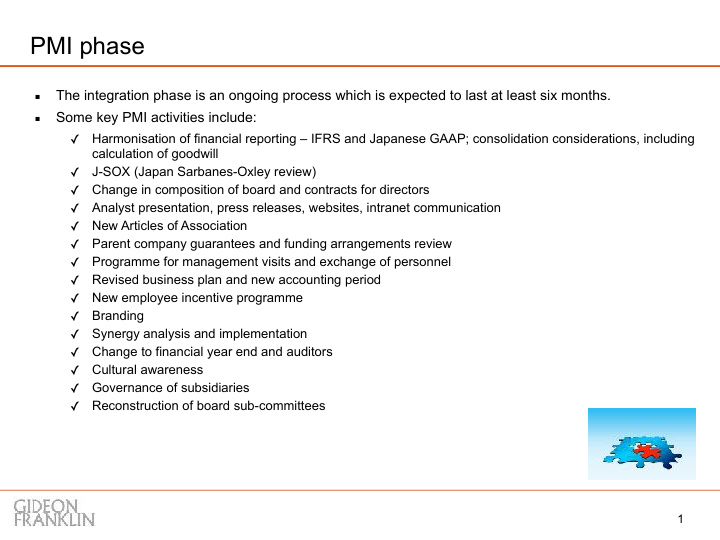



PMI phase ▪ The integration phase is an ongoing process which is expected to last at least six months. ▪ Some key PMI activities include: ✓ Harmonisation of financial reporting – IFRS and Japanese GAAP; consolidation considerations, including calculation of goodwill ✓ J-SOX (Japan Sarbanes-Oxley review) ✓ Change in composition of board and contracts for directors ✓ Analyst presentation, press releases, websites, intranet communication ✓ New Articles of Association ✓ Parent company guarantees and funding arrangements review ✓ Programme for management visits and exchange of personnel ✓ Revised business plan and new accounting period ✓ New employee incentive programme ✓ Branding ✓ Synergy analysis and implementation ✓ Change to financial year end and auditors ✓ Cultural awareness ✓ Governance of subsidiaries ✓ Reconstruction of board sub-committees 1
The acquisition is the easy part Pay for the acquisition and advisors… …but what to do next? There are cultural differences between Japan and the West When you buy a house do you knock it down or refurbish and improve? 2
Europe as an M&A destination for Japan Attractions of Europe Complications in Europe ❑ A lot of technologies ❑ Mix of languages and cultures ❑ European companies often have a global ❑ Choice of base presence, including Asia ❑ Gateway to Africa, Middle East, Turkey, India The Netherlands – popular for tax UK – language, business, Germany – most legal environment easiest important economy 3
Questions for discussion 1. How to make Japanese companies aware of the need for PMI prior to a catastrophe? 2. How to provide effective advice on distant cross-border transactions? 3. Lack of confidence in PMI prevents a company even considering a transaction – can this be solved? 4. Is the big difference between remuneration in Japan and overseas a barrier to integration? 5. Top companies have a diverse board. Will Japanese companies take on more directors from their growing overseas subsidiaries? 4
Recommend
More recommend